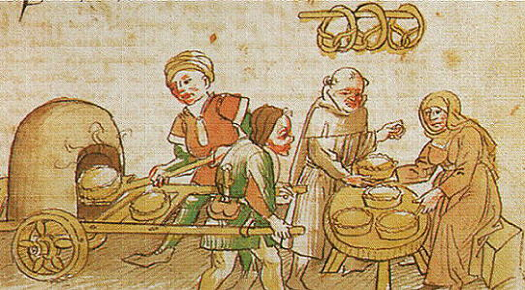A Short History of Pie

Murcian meat pies are relics from time when pie wasn’t a food so much as it was a strategy: a way to preserve edible odds and ends that you might otherwise lose as a result of spoilage. They were the original Tupperware in other words: handy, portable containers you could eat from. Notice here that I said eat from. For early pies weren’t meant to be eaten crust-and-all. That’s newfangled modern thinking…but more on that in a moment.
Food historians make the case that pie-eating dates to Greece and Rome. Here it really depends on what you mean by a pie. Pies of the ancient world were more akin to modern tarts: open-faced, made for immediate consumption. The Arabs also made pie-like pastries with top and bottom crusts yet they were not, at least to my way of thinking, true pies (though Murcian meat pies are definitely Arab influenced). For pie is as much a lifestyle — dare I say an attitude – as it is is type of baked good, one that evolved in the Middle Ages in Europe.
Everyone who’s ever prepared food has confronted the same problem: what to do with leftovers. The dilemma was especially vexing in the days before refrigeration, when fresh food degraded in an eye-blink. Cooking (which deactivates enzymes and kills harmful microbes) was one way to prevent such degradation. And if you could find a way to keep air away from your food, so much the better. Pies accomplished all these tasks at a single go, extending the shelf life of whatever was put into them for up to a week. More functional than delectable, they could be up to several feet across.
Of course you couldn’t make a behemoth like than out of any old crust. Today’s flaky-tender pâtes brisées are absolute sissies compared to the workhorse crusts of old. These brutes — called “coffins” among English speakers — started out as thick pastes of flour and water, pressed into deep, straight-sided pans or bottomless iron or wooden hoops to a thickness of an inch or more. They’d bake for hours in a low-heat oven and emerge like clay pots: stone-like in their hardness, probably with a flavor to match. Eating a pie like that simply entailed cracking it open, scooping out the contents and discarding the exterior, which presumably made a loud, hollow thunking sound when it hit the ground.
What did Medieval pies contain? Like Tupperware, just about anything. Fruits yes, but far more often meats and vegetables. Custards could go in, as could sauces which, combined with “meat-and-potatoes” ingredients created what could be thought of as early casseroles. Oh yes my friends, pie history is both broad and deep. I could easily drown!
I can’t help but wonder…is this all a dramatic lead-up to Epic Pi Day (3/14/15)?
I was wondering the same thing Melanie. 😀
What could be more Epic than a pie of part Arab origin with a crust of concentric circles to celebrate Epic Pi Day?
Maybe a post with the finished pie at exactly 3/14/15 9:26:53, the first few numbers of pi (3.141592653)?